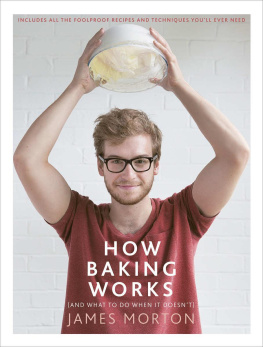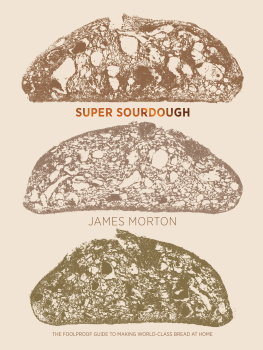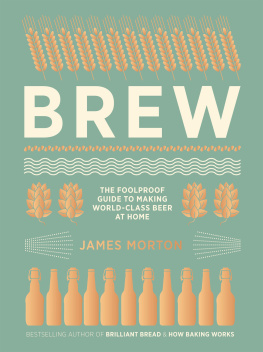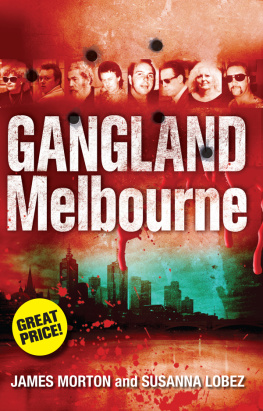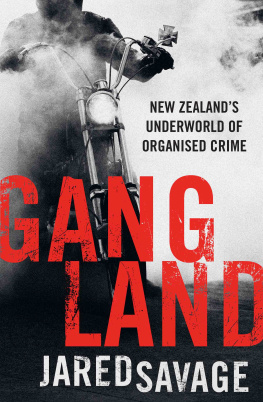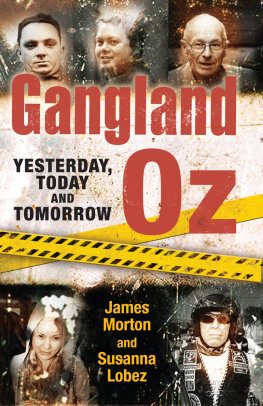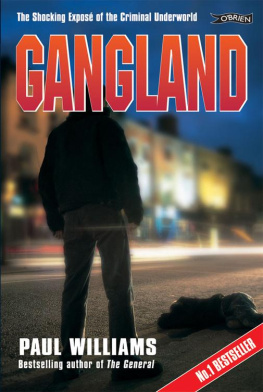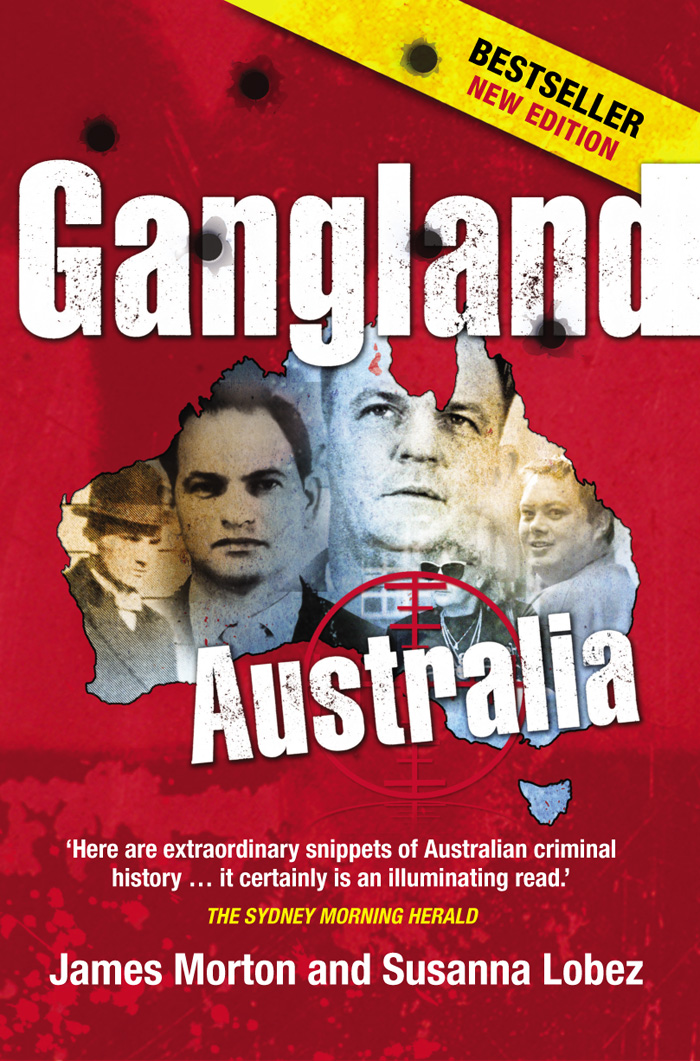Gangland
AUSTRALIA
Colonial Criminals to the Carlton Crew
James Morton
Susanna Lobez

Imperial to metric conversions
1 pound (weight) | 454 grams |
1 ounce | 28.3 grams |
1 stone (14 pounds) | 6.4 kilograms |
1 inch | 2.5 centimetres |
1 foot | 30.5 centimetres |
1 mile | 1.6 kilometres |
VICTORY BOOKS
An imprint of Melbourne University Publishing Limited
187 Grattan Street, Carlton, Victoria 3053, Australia
mup-info@unimelb.edu.au
www.mup.com.au
First published 2007
Reprinted 2007 (twice), 2008 (twice), 2009
This edition published 2010
Text James Morton and Susanna Lobez, 2010
Design and typography Melbourne University Publishing Ltd, 2007
This book is copyright. Apart from any use permitted under the Copyright Act 1968 and subsequent amendments, no part may be reproduced, stored in a retrieval system or transmitted by any means or process whatsoever without the prior written permission of the publishers.
Every attempt has been made to locate the copyright holders for material quoted in this book. Any person or organisation that may have been overlooked or misattributed may contact the publisher.
Text designed by Alice Graphics
Cover designed by Nada Backovic
Typeset in 9/14 pt Lino Letter Roman by Megan Ellis
Printed in Australia by Griffin Press, South Australia
National Library of Australia Cataloguing-in-Publication entry:
Morton, James, 1938
Gangland Australia: colonial criminals to the Carlton Crew/James Morton, Susanna Lobez.
Rev ed.
9780522857375 (pbk)
Includes index.
Bibliography.
Organised crimeAustraliaHistory.
GangsAustraliaHistory.
MafiaAustraliaHistory.
Lobez, Susanna.
364.1060994
For Patricia Rose and Alec Masel
and Dock Bateson with love
Contents
Preface
It was only when I came to Sydney and Melbourne in the 1990s that I realised how seriously the great villains in recent British crime were outpaced by Australian underworld identities. Some of the Sabinis of the 1920s, the Nashes of the 1950s, the Krays and the Richardsons of the 1960s, the Ahmeds of the 1980seven the feared, if little known, Adams family of the late 1990shadnt begun to leave the paddock by comparison with their Antipodean counterparts. The total number of their dead and disappeared victims was probably no more than those of the Darlinghurst Razor Wars of the 1920s and certainly nowhere near the tally of the current Melbourne struggle. Even the gangsters from New York, Chicago and Detroit during the Prohibition years might find themselves outgunned on the other side of the Pacific. The scales fell from my eyes. It was clear that there was a gripping book to be written about criminal gangs in Australia.
How did I ever start writing about crime? For some thirty yearswith time out to take up all-in wrestling, run a junk shop and (that last refuge of the derelict) teach English in ParisI ran a criminal defence practice in London. Although, over the years, I defended some of the biggest names in the game, I had lost heart telling the same old lies for the same old people to the same old magistrates and judges. My original clients were getting old and while their sons were keen to hear, yet again, how their dads had robbed the Clerkenwell bank on election day 1966, their grandchildren werent so keen to hear of two old codgers cutting up touches. There was also a change in the way legally aided cases were paid and it was not for the better. My bank manager and I sold my practice to two lawyers, one of whom died literally on his desk after a trip to Las Vegasfinanced by me, since he defaulted on the quarterly instalment. The last I heard of the other man was about ten years ago when he escaped from a prison in France. The bank manager kept the proceeds and I looked around for something to do.
I had already tried my hand at writing. I had reviewed films for ten years for a variety of magazines, had written a column on antiques for Diners Club magazine for just about as long, and had been the gambling correspondent for a girlie magazine where I subsequently stood in as the wine writer and, when the horoscopist failed to come up with his column, had been the divinatory Joan the Wad for a couple of months.
Many of my older and semi-retired clients were sorry to see me shut the doors and they kept in touch. The last thing a defending lawyer wants to know is the truth, but now I began to ask, What really happened? They were happy to tell me, and out of their recollections and some research came my 1992 book Gangland, which was a look at London gangs from the start of the twentieth century.
It attracted a bit of attention. On publication I had some trouble with a London family who were not happy with my description of them, but just as that was sorted out I had a message on my answering machine. Would I ring a Mr Francis Fraser?
I knew exactly who he was. I had defended him in the Parkhurst Riot trial of 1969. He is a sort of cross between Neddy Smith and Chopper Read. He was known as the Mad Dentist partly because he had been certified insane three times and partly because he was reputed to have pulled out the teeth of his victims with a pair of pliers. He had been acquitted of murder in a 1965 shooting but had been sentenced to a total of twenty years, every day of which he served as he lost more and more remission for tipping buckets of urine over prison screws, throwing food in their faces and, if they upset him (and he wasnt in a straitjacket at the time), attacking governors. Early in his life he had tried to hang the governor of one prison and he had certainly managed to hang the mans dog.
He had been happy with his defence when hed been found not guilty of incitement to murder, but had I somehow offended him in the book? He was the last person I wanted to talk to, but he wasnt the type to go away and there was nothing to do but return his call.
Ive got your book, he said with no preliminaries when I phoned back. I didnt buy it. I had it nicked. Im writing my story and I want you to do it for me. My agent didnt want me to do it; my family advised against; but it was, in Godfather terms, an offer I couldnt refuse. The book was a great success and, like Chopper Read, Fraser has gone on to appear in films, television commercials and cabaret, even at literary festivals, and together we have written another four books. Meanwhile I had written a history of the gangs of Britain and then, in 1998, Gangland International, which taught me far more about the Australian annals of crime than just Squizzy Taylor, the Shark Arm case and the Pyjama Girl mystery.
It was at this point that I met Susanna Lobez for the second time. We had previously met at a conference in Melbourne when I was editing a law magazine and she was hosting The Law Report on ABC Radio. She had been an actress, playing numerous lawyer roles, then retrained and worked as a barrister before turning to broadcasting. We got on well and over the years had kept in touch.
We met yet again in 2004. By this time Susanna had pulled together all her career strands as the host of Law Matters on ABC Television and I was steeped in Australian gang crime but realised that the book I wanted to write about it was something I could not do on my own. Who was going to read a history of Australian crime by a largely absentee Pom? Who better, then, to have as a writing partner than an Australian journalist and barrister? Susanna thought it was a good idea and put in the pitch to Melbourne University Publishing, and so


